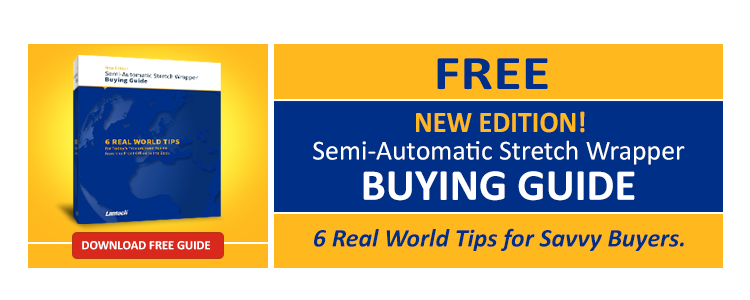Spec’ing a stretch wrapper for your requirements
You’re thinking about buying, replacing or upgrading a stretch wrapper. One of the first and most fundamental questions you always ask is, “how will it be loaded – with a forklift or a pallet jack?”

That invariably leads to a narrowing range of options, since some machines are designed to only be loaded by forklifts. And you might then assume that a machine which can be loaded with a pallet jack is the right choice because it can also, obviously, be loaded with a forklift. And you’d be right…sort of.
What we know from experience is that business changes. Not only does the nature of loads tend to change, but that labor costs, staffing, throughput etc. change as well.
And that means that it’s worth looking at options for upgrades and flexibility throughout the life of a machine before you buy one.
Evolving loads
It seems today that nearly every customer has specific requirements for load put-ups, pallet configurations, labeling, etc. Maybe you normally stack your product five rows high (call it 60″). Sooner or later your sales and marketing team will find an exciting new customer whose warehouse receiving requirements call for loads eight rows high. Wouldn’t you hate to tell someone the machine you recently bought won’t work? We didn’t think so.
Maybe you say this to changes in loads: “Ours can only stack 5 layers high. I’m not concerned.” OK. And you may well be right. But what if stronger cases, squared up and properly column stacked, gave you better protection. And what if better load containment actually allowed you to make better use of the trailer cube? Imagine what that would mean for your delivered costs to customers?
It could be that the length, width, height and weight of your loads will never change. But they’re not the only things that are likely to change.
Labor costs, staffing and throughput
The way your loading dock runs and what’s expected will change. We can virtually guarantee it. Not only will one of your process engineers recognize the opportunity to apply Lean methodology to reducing damage, waste and costs, but you’ll soon have to do more with less. That’s a basic fact of business.
And that’s why the forklift vs. pallet jack question is a false choice. You should plan for both pallet jacks and forklifts (even if you don’t use forklifts today). You should plan for modular capability to increase throughput rates and retrofit other options to extend your machine’s capability.
For instance, we know from working with thousands of customers that as soon as an operation shifts to forklifts, it creates difficult choices for the operator. What he’s supposed to do is:
- Carefully place the load
- Check his surroundings
- Back up
- Set the parking brake
- Lower the forks to the floor
- Unbuckle his seat belt
- Dismount the forklift
- Attach the film to the load
- Start the wrapper
- Climb on the forklift
- Buckle his seat belt
- Disengage the parking brake
- Raise the forks
- Move off to get the next load and bring it back
- Set it down
- Check his surroundings
- Back up
- Set the parking brake
- Lower the forks to the floor
- Unbuckle his seat belt
- Dismount the forklift
- Cut the film tail
- Tuck the film tail in
- Climb on the truck
- Disengage the parking brake
- Pick up the load and remove it from the wrapper
- And then repeat
Assuming you’ve actually been on a loading dock, you’re probably chuckling now. 27 steps…right. The operator is going to skip the safety belt and maybe the brake. Once he dismounts the forklift, he’s going to wait and watch the stretch wrapper go through the entire wrap cycle. That’s two minutes of wasted labor time. Instead of getting the next load or doing something productive, he’s going to “help” the wrapper do it’s job.
To fully realize the value of your wrapper, think about simple features that automate or eliminate the opportunities to make bad choices.
Here’s a quick example.
Engineering in flexibility
Whether you’re a plant engineer developing the spec for your next wrapper, or a company owner or GM wanting to invest prudently for the future, establish flexibility as one of your criteria. It will ensure the machine you select delivers optimal performance for your evolving requirements, and it will retain more value as well.
Wondering what other factors to consider? Download our free eBook – a Guide to Selecting a Pallet Wrapper.

image – fuelcelltoday
This post was published on March 6, 2015 and updated on November 2, 2018.
March 6, 2015
